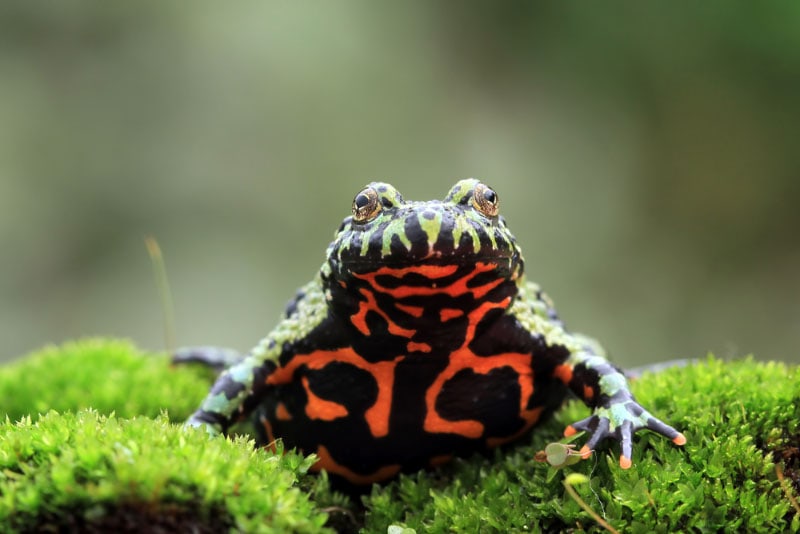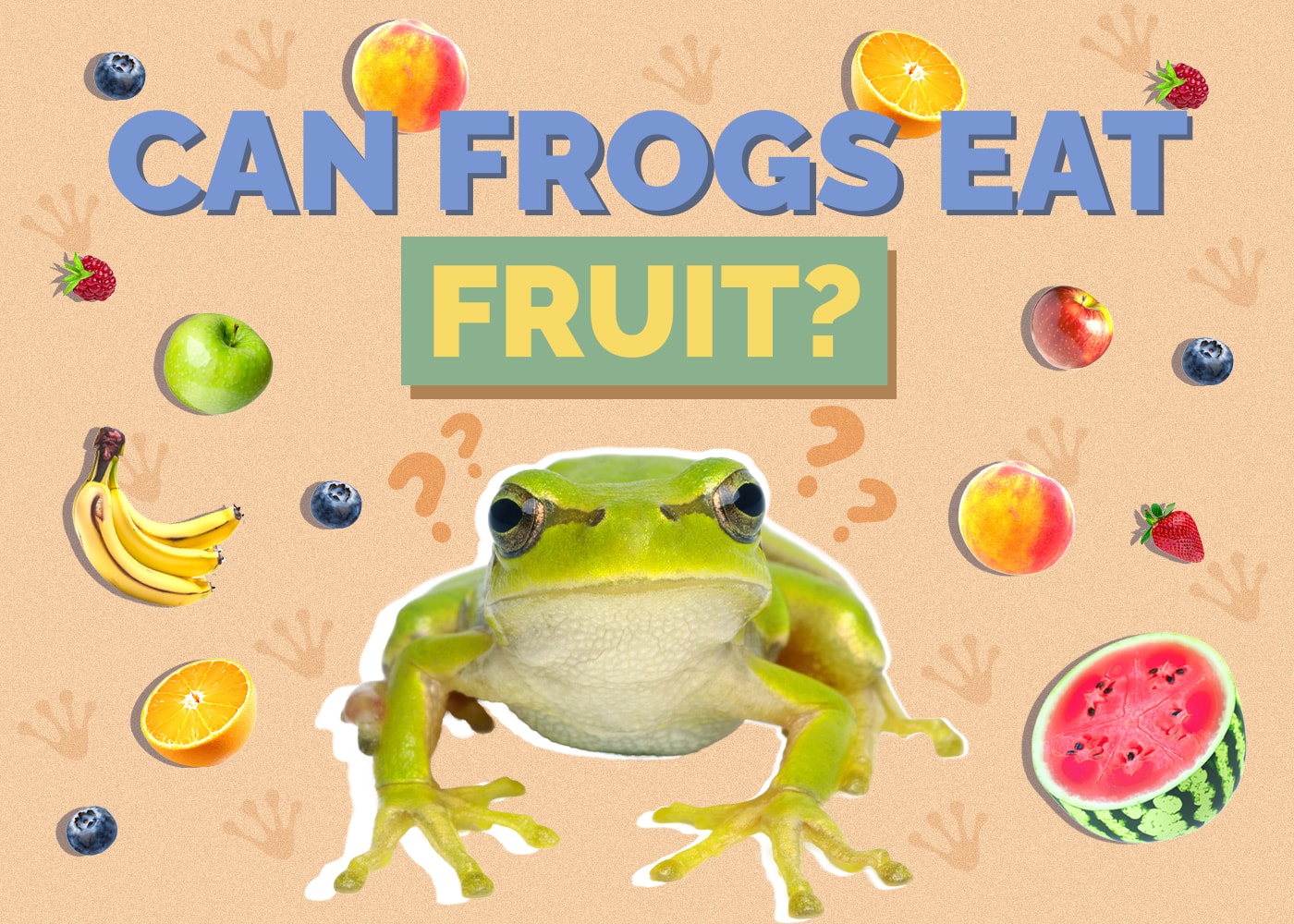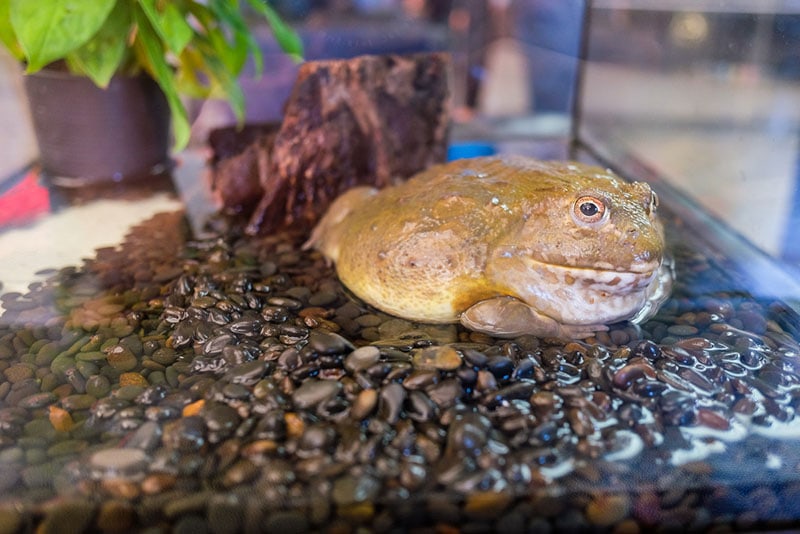20 Types Of Frogs (Vet-Verified Info With Pictures)

Updated on
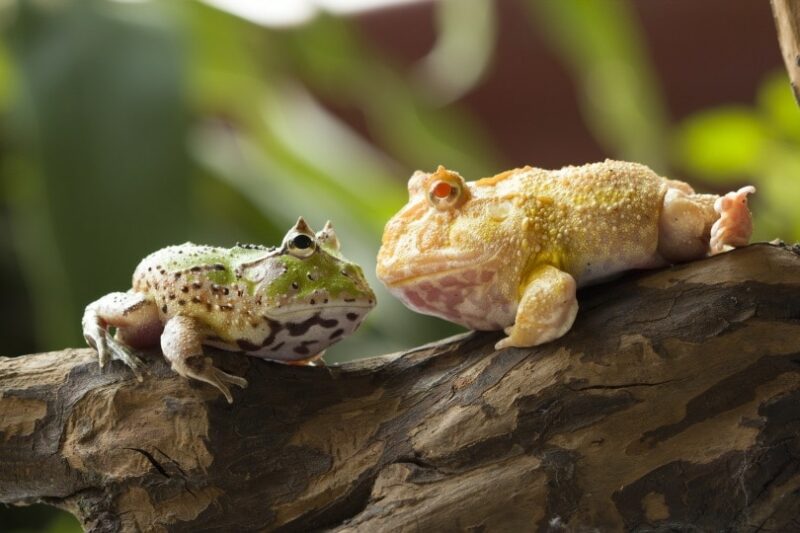
There are known to be several thousand species of frogs around the world, with new species still being discovered. From the aptly named Common Frog, which is widely distributed across Europe and Asia, and the Chorus Frog, one of the most common species in North America, to the Microhylid Frog, which is only found in two very small areas in Madagascar, frogs vary in color, size, and prevalence. They also vary in their diet, whether they can be handled, and their suitability for keeping as pets.
Below, we look at 20 types of frogs, including some common pet species and some that should probably not be kept as pets.
The 20 Types of Frogs
1. African Bullfrog (Pyxicephalus adspersus)
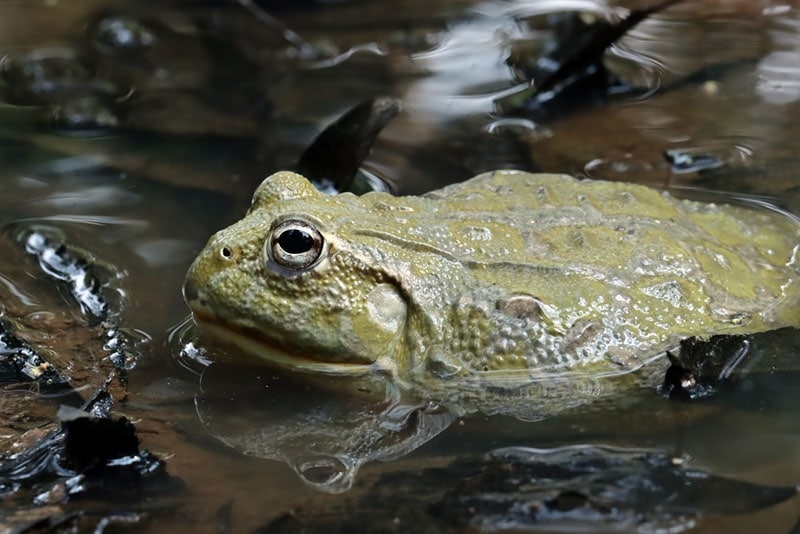
| Pet: | Yes |
| Size: | Approximately 10 inches |
We’ll start with one of the most popular pet frog species, the African Bullfrog. Males can grow up to around 10 inches, which makes them safer to handle, and the species will tolerate occasional handling. The frog can live over 40 years as a pet 1 and, in the wild, spends much of their time living in a hole underground. You will need a large tank but the African Bullfrog is a good choice as a pet.
2. African Dwarf Frog (Hymenochirus)
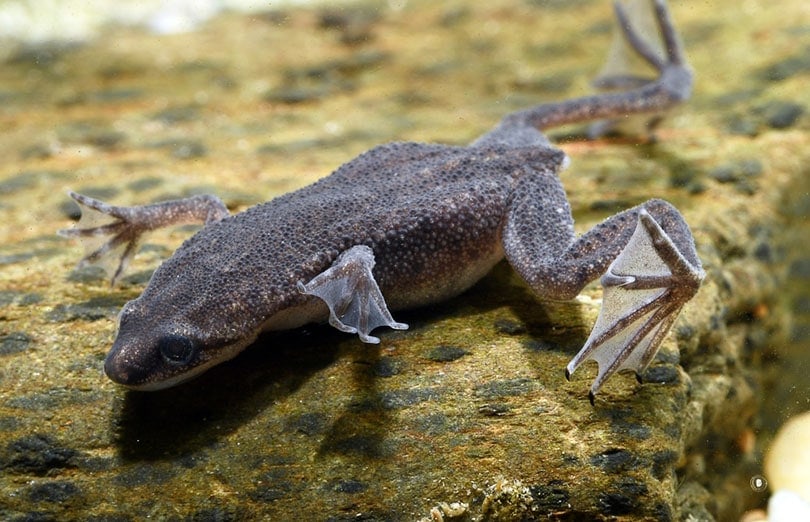
| Pet: | Yes |
| Size: | 1.5 inches |
Although they hail from the same part of the world, African Dwarf Frogs are quite different from Bullfrogs. They are fully aquatic, only needing to surface to breathe, and they typically only measure around 3 inches. This means owners won’t need such a large tank, but you will need to provide water. You can keep the African Dwarf Frog in the same tank with some fish, but they aren’t the best swimmers and may struggle to keep up during mealtime.
3. American Bullfrog (Lithobates catesbeianus)
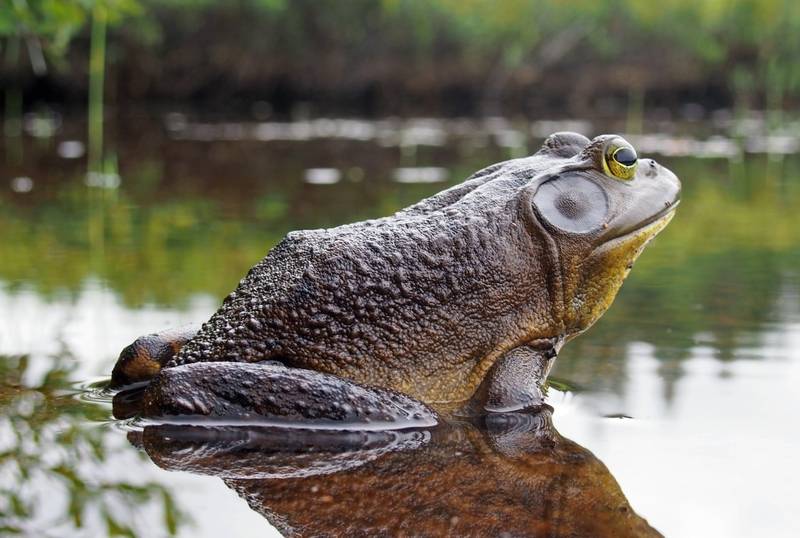
| Pet: | Yes |
| Size: | 6 inches |
The American Bullfrog is one of the most commonly seen species in North America. They can technically be kept as a pet, but the American Bullfrog is a shy frog that can jump very long distances. This means that they will require a large paludarium with plenty of space and that includes water, otherwise, your Bullfrog will keep jumping against the tank wall. The species is best kept as a pet to watch, rather than to be handled.
4. American Green Tree Frog (Dryophytes cinereus / Hyla cinerea)
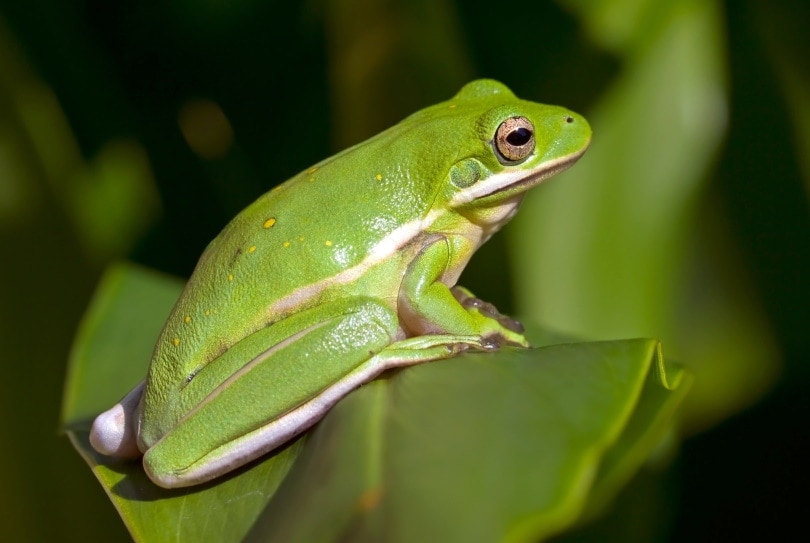
| Pet: | Yes |
| Size: | Up to 2 ½ inches |
The American Green Tree Frog is a small frog but their vibrant color and arboreal nature make them an intriguing pet that is fun to watch. The American Green Tree Frog is, as their name suggests, a bright green color. They are a good choice as a first frog because they don’t require any special heating in their tank unless the room they live in gets cold in the evenings. And because they are arboreal and small, the tree frog benefits from vertical space and can live in a relatively small enclosure.
5. American Toad (Anaxyrus americanus)

| Pet: | Yes |
| Size: | 3 inches |
The American Toad is another good pet species, but there are some caveats. The toad will anecdotally tolerate occasional handling but this needs to be kept to a minimum because this little amphibian gives off a substance that can be an irritant to the eyes, and the oils from human skin can cause harm to the toad. And while the American Toad might not be as colorful as some species, their skin color can sometimes change in tone.
6. Bumblebee Dart Frog (Dendrobates leucomelas)
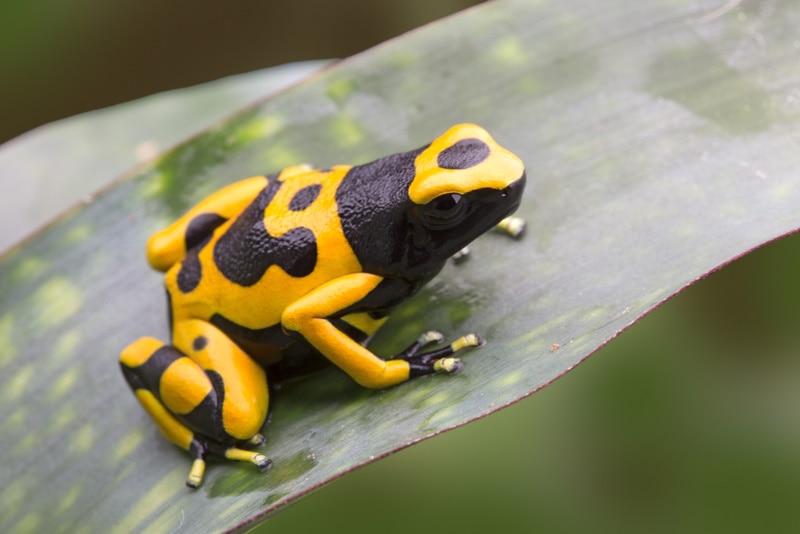
| Pet: | Yes |
| Size: | 1.5 inches |
While some frogs and toads can look quite plain and even a little ugly, others have stunning and vibrant colors. The Bumblebee Dart Frog may only be small, measuring just over an inch, but what they lack in size they make up for in vibrancy with their black and yellow markings. You won’t be able to handle this frog often and you will need to manage temperature and humidity levels in the tank, so there are easier first pet frog species.
7. Common Frog (Rana temporaria)
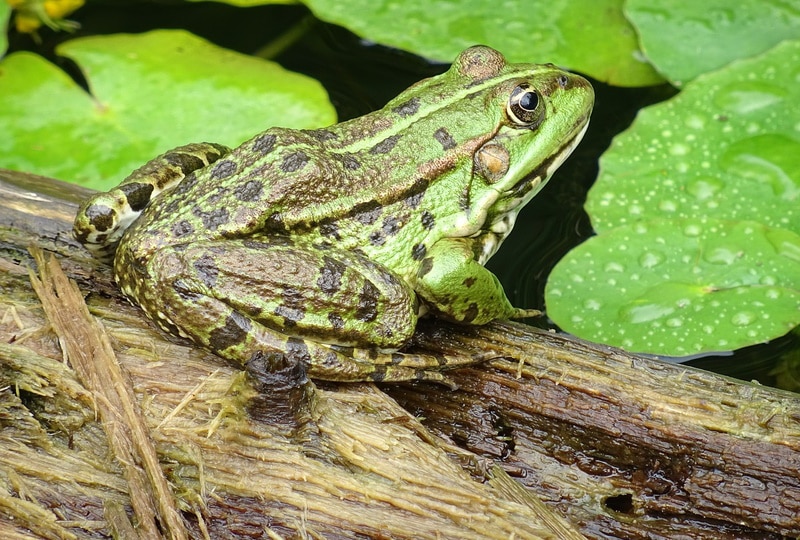
| Pet: | Yes |
| Size: | 3.5 inches |
The Common Frog is found throughout the UK and other parts of Europe. Technically, it can be kept as a pet, but it may not be the best choice. Common Frogs have a long leap and they anecdotally do not recognize glass as being a solid barrier so yours may injure themselves quite frequently even if you do provide a large tank.
8. Glass Frog (Centrolenidae)
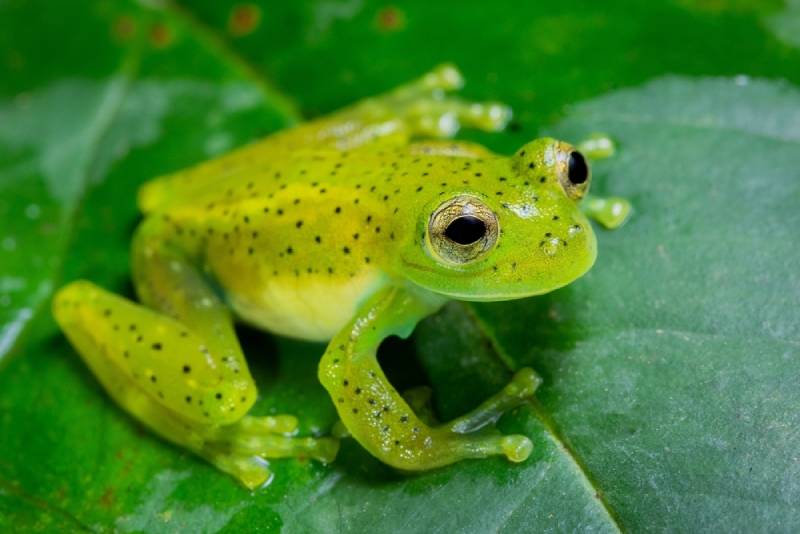
| Pet: | Not recommended |
| Size: | 1-3 inches |
Glass Frogs are unusual in their appearance because they have translucent skin that looks as though they are covered in glass. Their underbellies are transparent which means that you can see their heart beating, and this is one of the reasons that people consider them as pets. They are difficult to care for and will need a tank at least with at least a 20-gallon capacity that is taller than it is wide because these are arboreal frogs. They need special lighting, heat, and humidity levels, and the tank needs regular cleaning. They should not be considered the best species for first-time frog keepers.
9. Golden Mantella (Mantella aurantiaca)
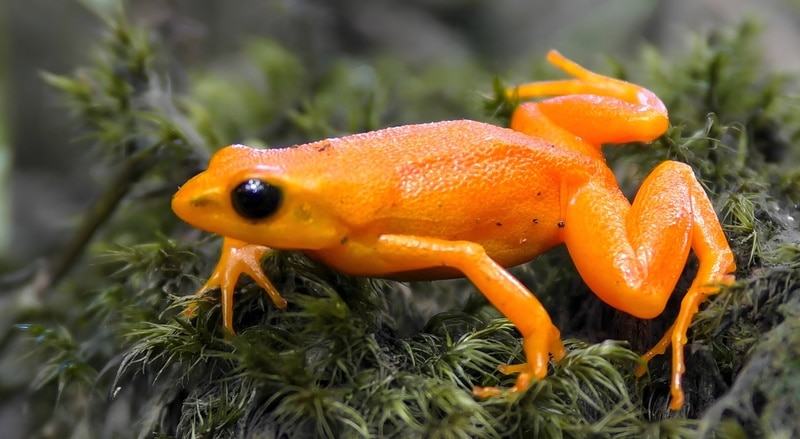
| Pet: | No (Endangered) |
| Size: | 1 inch at most |
The Golden Mantella is often mistaken for a poisonous dart frog because of its orange color, although some Mantellas may appear more brown in hue. As this species is endangered, they are not considered good options as pets.
10. Goliath Frog (Conraua goliath)
| Pet: | No |
| Size: | 12 inches (large specimen) |
As you can guess from its name, the Goliath Frog is a giant of the frog world, potentially growing to 12 inches or more. It is, in fact, the largest frog species in the world. Unusually for frogs, males tend to be larger than females, and rather than croaking like other frog species, males whistle to attract a mate. In the wild, the Goliath Frog is considered endangered; therefore, they shouldn’t be kept as pets, as the illegal capture of these frogs is decimating their populations.
11. Gray Treefrog (Dryophytes versicolor)
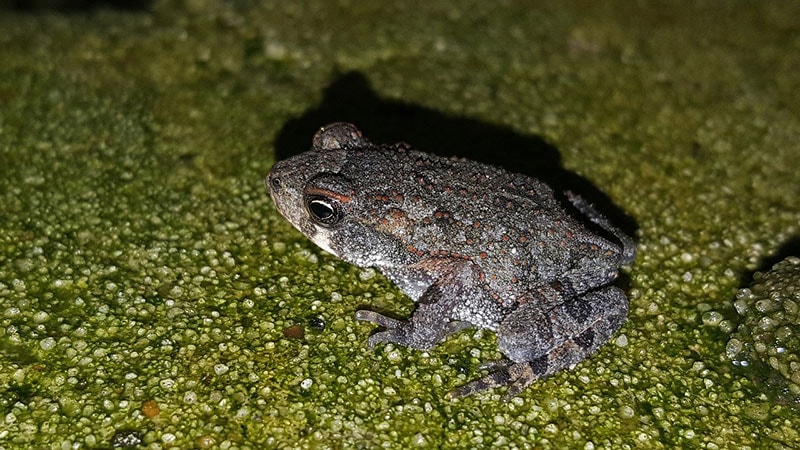
| Pet: | Yes |
| Size: | Up to 2 inches |
The Gray Tree Frog is native to the U.S. and it has a rugged, warty appearance. It is arboreal, which means that its enclosure should be vertically spacious and you will need to provide a 20-gallon tank to ensure that it has enough space. If you are considering a Gray Treefrog, ensure you adopt your pet from a reputable breeder, as it’s easy to confuse this species, and you might end up with a different frog!
12. Green Frog (Lithobates clamitans / Rana clamitans)

| Pet: | Yes |
| Size: | Up to 4 inches |
Green Frogs are native to the U.S. and are a popular pet species because they grow to an average size and are relatively calm, which means they will anecdotally tolerate occasional handling. The species will eat just about anything, as long as it fits in their mouth, which makes handling their diet somewhat tricky, as they may eat food items they’re not supposed to.
13. Madagascar Tomato Frog (Dyscophus antongilii)
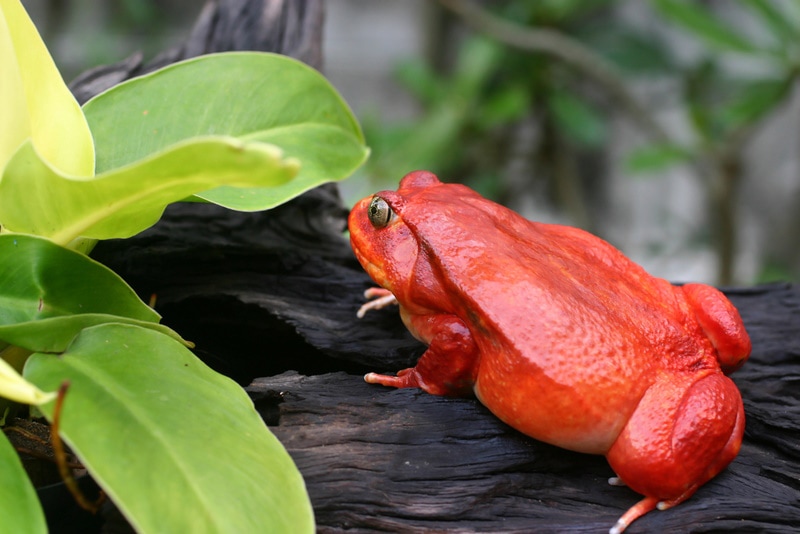
| Pet: | No |
| Size: | Up to 4 inches (females only), males smaller |
The Madagascar Tomato Frog is an unusual-looking species that is round and red, like a tomato. These frogs hail from Madagascar and are hardy frogs that can survive in a variety of habitats. However, being endemic to Madagascar, adopting them outside of the region is not encouraged, as they play a very important role in their native natural habitat.
14. Malayan Horned Frog (Pelobatrachus nasutus)
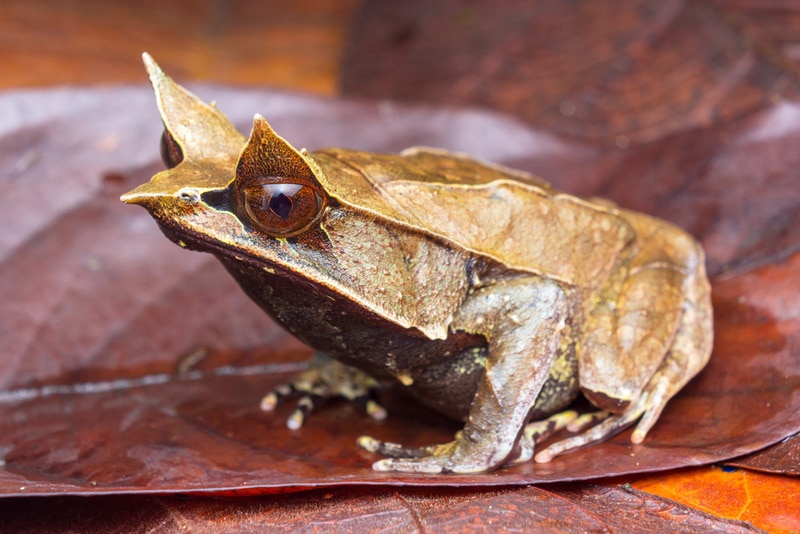
| Pet: | No |
| Size: | 5 inches |
The Malayan Horned Frog has a unique appearance. This species has a brown back and two sharp-looking horns atop their head, giving the overall appearance of a brown leaf. The frog may also have a rusty brown underbelly and is very well camouflaged on the ground of the forests they reside in.
15. Mimic Poison Frog (Ranitomeya imitator)
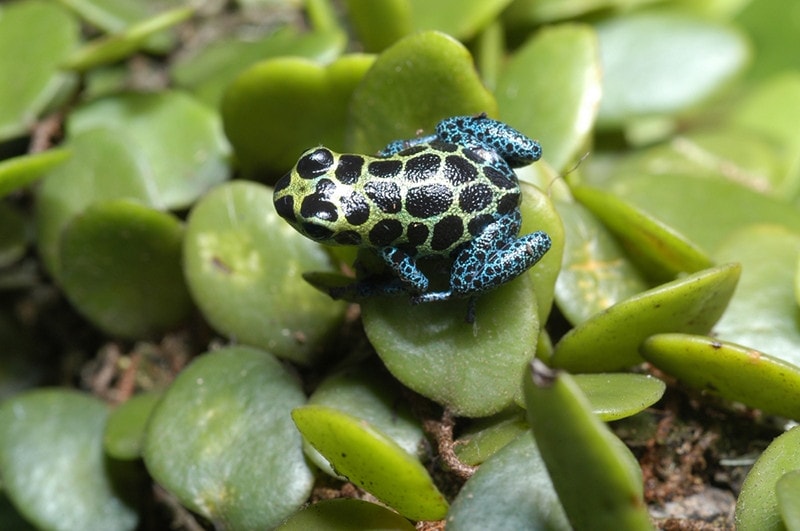
| Pet: | Controversial, not recommended |
| Size: | Around 1 inch |
The Mimic Poison Frog is toxic, but while it does deliver enough toxin to make a person ill, it doesn’t have lethal levels in most cases. However, it shouldn’t be handled, so if it is kept as a pet, the Mimic Poison Frog, which gets its name from the fact that it mimics the coloration and markings of more toxic Poison Frogs, should be watched rather than petted. Though their wild population is stable, they are often illegally collected and exported, which makes their ownership somewhat controversial for many frog enthusiasts.
16. Pacman Frog (Ceratophrys)
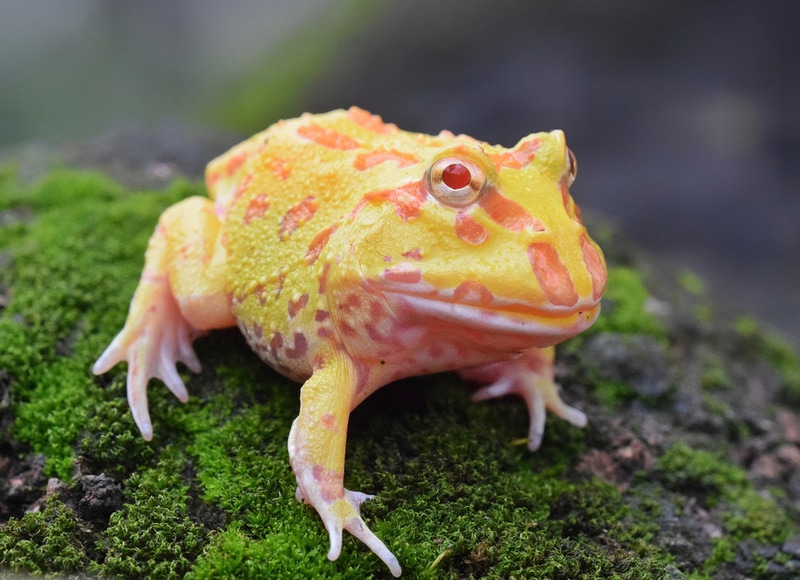
| Pet: | Yes |
| Size: | Around 6 inches |
The Pacman Frog is one of the most popular pet frog species. However, you may need to wear gloves when handling one because they have a tendency to defend their territory vigorously so you may get bitten. The frog gets their name from the fact that their mouth takes up roughly half of their head, just like Pacman.
17. Red-Eyed Tree Frog (Agalychnis callidryas)
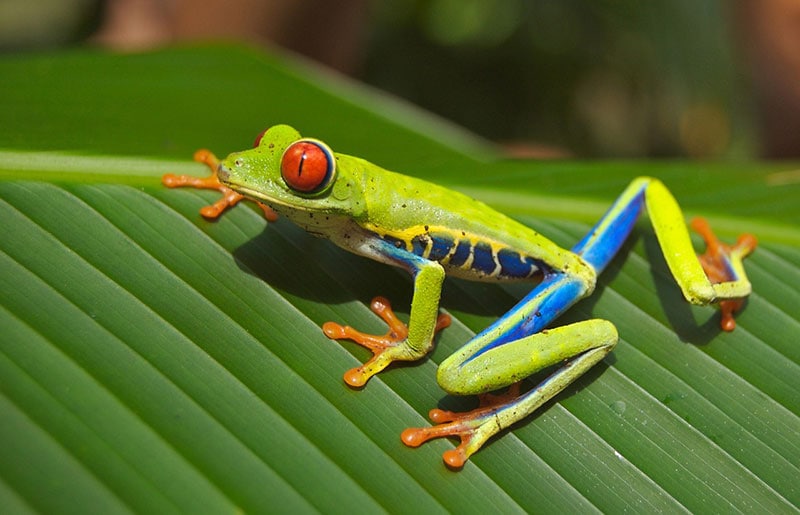
| Pet: | Yes |
| Size: | 3 inches (females), males up to 2 inches |
The Red-Eyed Tree Frog is another very popular pet species, likely because of their striking color. The frog has a green body with blue legs and a white underbelly, as well as large red eyes. They also have bright orange feet. They have the nickname of monkey frog because of how far they can leap and those colorful feet are webbed with sticky pads to help grip onto surfaces.
18. Vietnamese Mossy Frog (Theloderma corticale)
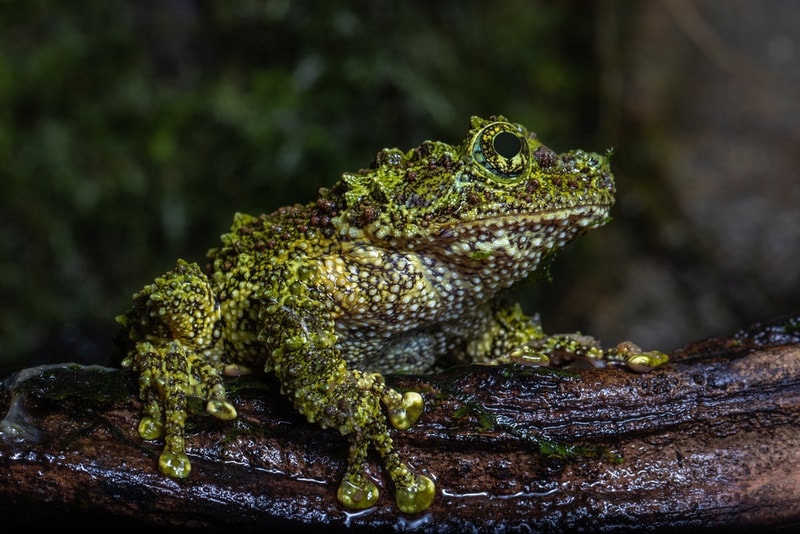
| Pet: | Yes |
| Size: | 3.5 inches |
The Vietnamese Mossy Frog is another master of camouflage. Their coloring means that they blend in perfectly with the mossy floor where they live. Although they can be kept as pets, they are not recommended for new owners and experienced keepers need to research the exact habitat conditions they require to thrive.
19. Waxy Monkey Frog (Phyllomedusa sauvagii)
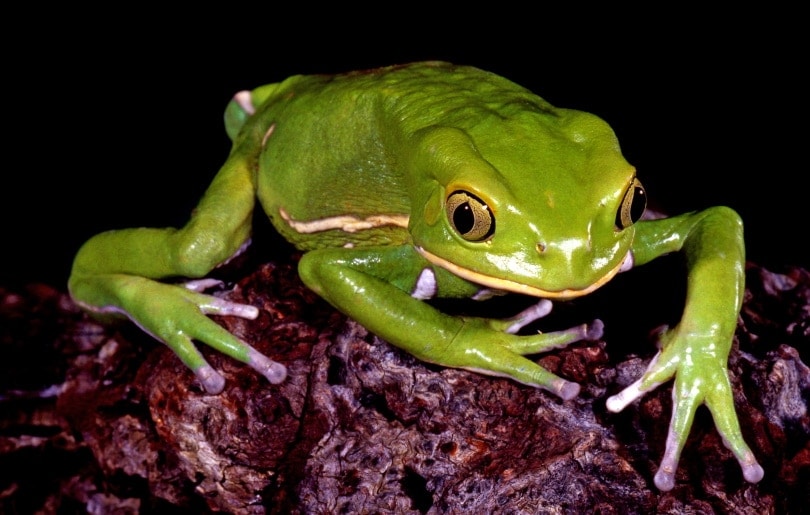
| Pet: | Yes |
| Size: | 3 inches |
The Waxy Monkey Frog is named for their tree climbing and acrobatic prowess, as well as for their waxy finish. The species does not enjoy being handled but is relatively easy to care for which makes them a good choice as a beginner frog for those who want to watch their pet, rather than pick them up to handle.
20. Wood Frog (Lithobates sylvaticus / Rana sylvatica)
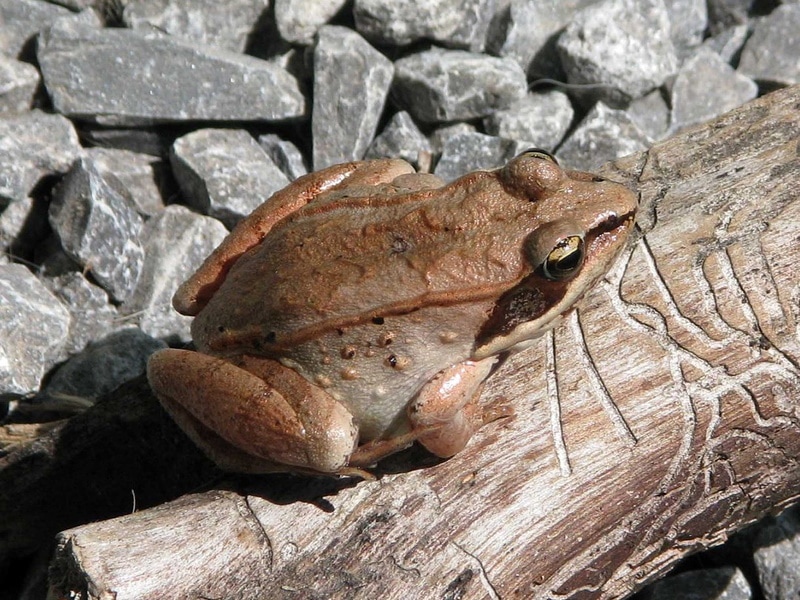
| Pet: | Yes |
| Size: | Around 2.5 inches |
The Wood Frog is another species native to North America that is named for their camouflage capabilities. They are interesting because they have developed the ability to freeze during the winter months and then thaw out when the weather warms up. Keepers do need to research the species, but they are considered a good pet frog because they are relatively easy to care for.
Do Frogs Make Good Pets?
Frogs can make good pets, but owners need to research the species they are getting and ensure that they provide good housing and conditions. Some frogs are arboreal, which means they live in trees in the wild, and they need taller tanks, rather than wider ones, for example. Some spend the vast majority of their time in water and may even be able to live with fish.
Generally speaking, frogs are hands-off pets, as even the non-toxic species may harbor pathogens harmful to humans, such as Salmonella.
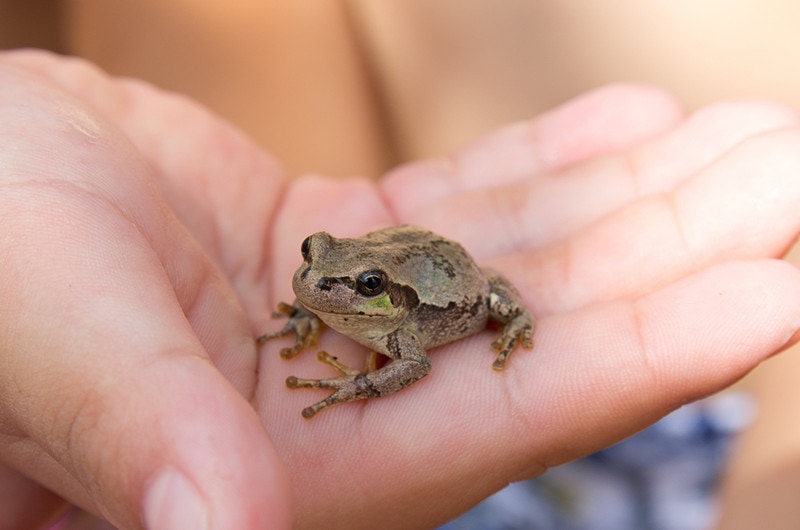
Do Frogs Like to Be Petted?
Rarely do frogs like to be petted. Some may tolerate being handled but even they won’t like to be stroked. Other species are very shy and will never enjoy being handled. These frogs are best kept for observation, rather than being picked up and petted.
Can Frogs Bond With Humans?
Frogs don’t really bond with humans in the way a cat or dog would. Frogs may anecdotally bond with humans in their own way. However, frogs do not show affection in the way we expect, so you should never expect to cuddle or even stroke a pet frog, no matter how long you have had them or how close the bond between you seems to be in your mind. They are also usually not familial animals in the wild, which means that most frogs choose to live a solitary life.
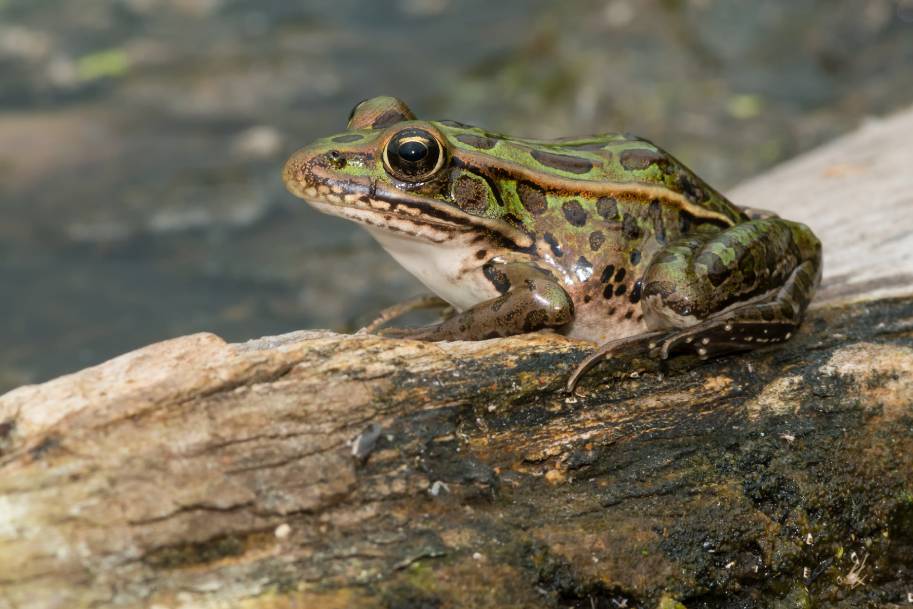
Conclusion
Frogs can make good pets. They are intriguing animals and some have truly unique habits or features. However, while they don’t need walking or grooming like some other pets, they do need proper care to ensure that they live a long and fulfilled life. There are several thousand species of frogs in the world and we have covered just 20 of them. There are many others with their own unique characteristics.
Featured Image Credit: agus fitriyanto suratno, Shutterstock


